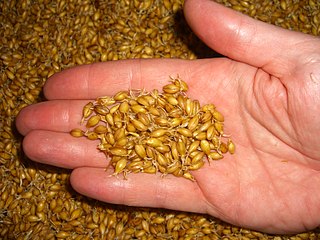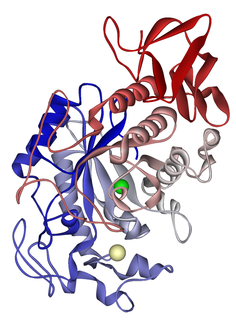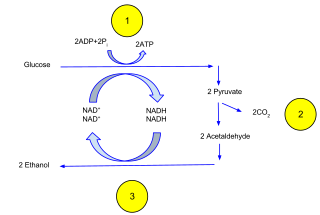Related Research Articles

Malt is germinated cereal grain that has been dried in a process known as "malting". The grain is made to germinate by soaking in water and is then halted from germinating further by drying with hot air.

Polysaccharides, or polycarbohydrates, are the most abundant carbohydrates found in food. They are long chain polymeric carbohydrates composed of monosaccharide units bound together by glycosidic linkages. This carbohydrate can react with water (hydrolysis) using amylase enzymes as catalyst, which produces constituent sugars. They range in structure from linear to highly branched. Examples include storage polysaccharides such as starch, glycogen and galactogen and structural polysaccharides such as cellulose and chitin.

Starch or amylum is a polymeric carbohydrate consisting of numerous glucose units joined by glycosidic bonds. This polysaccharide is produced by most green plants for energy storage. Worldwide, it is the most common carbohydrate in human diets, and is contained in large amounts in staple foods such as wheat, potatoes, maize (corn), rice, and cassava (manioc).
A diastase is any one of a group of enzymes that catalyses the breakdown of starch into maltose. Alpha amylase degrades starch to a mixture of the disaccharide maltose; the trisaccharide maltotriose, which contains three α (1-4)-linked glucose residues; and oligosaccharides, known as dextrins, that contain the α (1-6)-linked glucose branches.

An amylase is an enzyme that catalyses the hydrolysis of starch into sugars. Amylase is present in the saliva of humans and some other mammals, where it begins the chemical process of digestion. Foods that contain large amounts of starch but little sugar, such as rice and potatoes, may acquire a slightly sweet taste as they are chewed because amylase degrades some of their starch into sugar. The pancreas and salivary gland make amylase to hydrolyse dietary starch into disaccharides and trisaccharides which are converted by other enzymes to glucose to supply the body with energy. Plants and some bacteria also produce amylase. Specific amylase proteins are designated by different Greek letters. All amylases are glycoside hydrolases and act on α-1,4-glycosidic bonds.

Maltase is one type of alpha-glucosidase enzymes located in the brush border of the small intestine. This enzyme catalyzes the hydrolysis of disaccharide maltose into two simple sugars of glucose. Maltase is found in plants, bacteria, yeast, humans, and other vertebrates. It is thought to be synthesized by cells of the mucous membrane lining the intestinal wall.

An exoenzyme, or extracellular enzyme, is an enzyme that is secreted by a cell and functions outside that cell. Exoenzymes are produced by both prokaryotic and eukaryotic cells and have been shown to be a crucial component of many biological processes. Most often these enzymes are involved in the breakdown of larger macromolecules. The breakdown of these larger macromolecules is critical for allowing their constituents to pass through the cell membrane and enter into the cell. For humans and other complex organisms, this process is best characterized by the digestive system which breaks down solid food via exoenzymes. The small molecules, generated by the exoenzyme activity, enter into cells and are utilized for various cellular functions. Bacteria and fungi also produce exoenzymes to digest nutrients in their environment, and these organisms can be used to conduct laboratory assays to identify the presence and function of such exoenzymes. Some pathogenic species also use exoenzymes as virulence factors to assist in the spread of these disease-causing microorganisms. In addition to the integral roles in biological systems, different classes of microbial exoenzymes have been used by humans since pre-historic times for such diverse purposes as food production, biofuels, textile production and in the paper industry. Another important role that microbial exoenzymes serve is in the natural ecology and bioremediation of terrestrial and marine environments.

Dextrins are a group of low-molecular-weight carbohydrates produced by the hydrolysis of starch and glycogen. Dextrins are mixtures of polymers of D-glucose units linked by α-(1→4) or α-(1→6) glycosidic bonds.

In brewing and distilling, mashing is the process of combining a mix of ground grains – typically malted barley with supplementary grains such as corn, sorghum, rye, or wheat – known as the "grain bill" with water and then heating the mixture. Mashing allows the enzymes in the malt to break down the starch in the grain into sugars, typically maltose to create a malty liquid called wort.

Ethanol fermentation, also called alcoholic fermentation, is a biological process which converts sugars such as glucose, fructose, and sucrose into cellular energy, producing ethanol and carbon dioxide as by-products. Because yeasts perform this conversion in the absence of oxygen, alcoholic fermentation is considered an anaerobic process. It also takes place in some species of fish where it provides energy when oxygen is scarce.

Brown rice (malt) syrup, also known as rice syrup or rice malt, is a sweetener which is rich in compounds categorized as sugars and is derived by steeping cooked rice starch with saccharifying enzymes to break down the starches, followed by straining off the liquid and reducing it by evaporative heating until the desired consistency is reached. The enzymes used in the saccharification step are supplied by an addition of sprouted barley grains to the rice starch or by adding bacterial- or fungal-derived purified enzyme isolates.

Glucose syrup, also known as confectioner's glucose, is a syrup made from the hydrolysis of starch. Glucose is a sugar. Maize (corn) is commonly used as the source of the starch in the US, in which case the syrup is called "corn syrup", but glucose syrup is also made from potatoes and wheat, and less often from barley, rice and cassava.p. 21
Aleurone is a protein found in protein granules of maturing seeds and tubers. The term also describes one of the two major cell types of the endosperm, the aleurone layer. The aleurone layer is the outermost layer of the endosperm, followed by the inner starchy endosperm. This layer of cells is sometimes referred to as the peripheral endosperm. It lies between the pericarp and the hyaline layer of the endosperm. Unlike the cells of the starchy endosperm, aleurone cells remain alive at maturity. The ploidy of the aleurone is (3n) as a result of double fertilization].

Beta-amylase is an enzyme with the systematic name 4-alpha-D-glucan maltohydrolase. This enzyme catalyses the following chemical reaction:

Mash ingredients, mash bill, mashbill, or grain bill are the materials that brewers use to produce the wort that they then ferment into alcohol. Mashing is the act of creating and extracting fermentable and non-fermentable sugars and flavor components from grain by steeping it in hot water, and then letting it rest at specific temperature ranges to activate naturally occurring enzymes in the grain that convert starches to sugars. The sugars separate from the mash ingredients, and then yeast in the brewing process converts them to alcohol and other fermentation products.

Glycoside hydrolases catalyze the hydrolysis of glycosidic bonds in complex sugars. They are extremely common enzymes with roles in nature including degradation of biomass such as cellulose (cellulase), hemicellulose, and starch (amylase), in anti-bacterial defense strategies, in pathogenesis mechanisms and in normal cellular function. Together with glycosyltransferases, glycosidases form the major catalytic machinery for the synthesis and breakage of glycosidic bonds.

Alpha-amylase(α-amylase) is an enzyme that hydrolyses alpha bonds of large, alpha-linked polysaccharides, such as starch and glycogen, yielding shorter chains thereof, dextrins, and maltose. It is the major form of amylase found in humans and other mammals. It is also present in seeds containing starch as a food reserve, and is secreted by many fungi. It is a member of glycoside hydrolase family 13.

α-Glucans (alpha-glucans) are polysaccharides of D-glucose monomers linked with glycosidic bonds of the alpha form. α-Glucans use cofactors in a cofactor site in order to activate a glucan phosphorylase enzyme. This enzyme causes a reaction that transfers a glucosyl portion between orthophosphate and α-I,4-glucan. The position of the cofactors to the active sites on the enzyme are critical to the overall reaction rate thus, any alteration to the cofactor site leads to the disruption of the glucan binding site.
Qū, qú, qūniè, jiǔqū, or jiǔmǔ is a type of East Asian dried fermentation starter grown on a solid medium and used in the production of traditional Chinese alcoholic beverages. The Chinese character 曲/麹 is romanised as qū in pinyin, chhu or chu in other transcription systems. The literal translation of jiǔqū is "liquor ferment", although "liquor mold" or "liquor starter" are adequate descriptions.

Neopullulanase is an enzyme of the alpha-amylase family with systematic name pullulan 4-D-glucanohydrolase (panose-forming). This enzyme principally catalyses the following chemical reaction by cleaving pullulan's alpha-1,4-glucosidic bonds:
References
- ↑ Rogosa, Eli (2016). Restoring Heritage Grains: The Culture, Biodiversity, Resilience, and Cuisine of Ancient Wheats. Chelsea Green Publishing. p. 224. ISBN 978-1-60358-671-9.
- ↑ Spoehr, H. A.; Milner, Harold W. (1939). "Starch Dissolution and Amylolytic Activity in Leaves". Proceedings of the American Philosophical Society. 81 (1): 37–78. JSTOR 984965.
- ↑ Ghiena, Christine; Schulz, Margot; Schnabl, Heide (1993). "Starch Degradation and Distribution of the Starch-Degrading Enzymes in Vicia faba Leaves. Diurnal Oscillation of Amylolytic Activity and Starch Content in Chloroplasts". Plant Physiology. 101 (1): 73–79. doi:10.1104/pp.101.1.73. JSTOR 4274935. PMC 158649 . PMID 12231667.
- ↑ Pervez, Sidra; Aman, Afsheen; Iqbal, Samina; Siddiqui, Nadir Naveed; Ul Qader, Shah Ali (December 2014). "Saccharification and liquefaction of cassava starch: an alternative source for the production of bioethanol using amylolytic enzymes by double fermentation process". BMC Biotechnology. 14 (1): 49. doi: 10.1186/1472-6750-14-49 . PMC 4048251 . PMID 24885587.
- ↑ Marchal, LM; Jonkers, J; Franke, GT; de Gooijer, CD; Tramper, J (5 February 1999). "The effect of process conditions on the α-amylolytic hydrolysis of amylopectin potato starch: An experimental design approach". Biotechnology and Bioengineering. 62 (3): 348–357. doi:10.1002/(sici)1097-0290(19990205)62:3<348::aid-bit11>3.0.co;2-f. PMID 10099546. INIST:1724996.